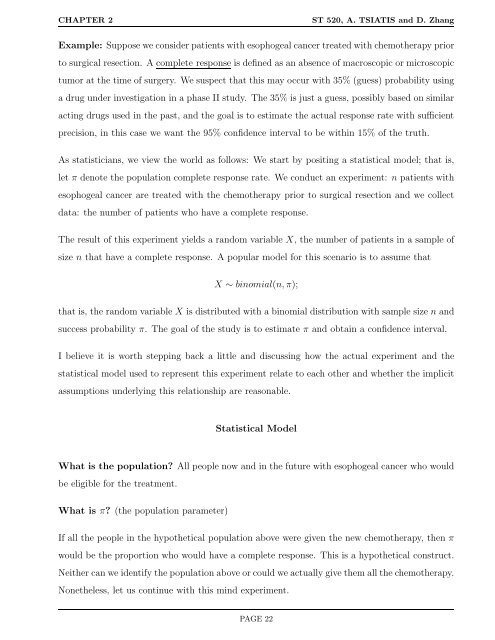ST 520 Statistical Principles of Clinical Trials - NCSU Statistics ...
ST 520 Statistical Principles of Clinical Trials - NCSU Statistics ...
ST 520 Statistical Principles of Clinical Trials - NCSU Statistics ...
You also want an ePaper? Increase the reach of your titles
YUMPU automatically turns print PDFs into web optimized ePapers that Google loves.
CHAPTER 2 <strong>ST</strong> <strong>520</strong>, A. TSIATIS and D. Zhang<br />
Example: Suppose we consider patients with esophogeal cancer treated with chemotherapy prior<br />
to surgical resection. A complete response is defined as an absence <strong>of</strong> macroscopic or microscopic<br />
tumor at the time <strong>of</strong> surgery. We suspect that this may occur with 35% (guess) probability using<br />
a drug under investigation in a phase II study. The 35% is just a guess, possibly based on similar<br />
acting drugs used in the past, and the goal is to estimate the actual response rate with sufficient<br />
precision, in this case we want the 95% confidence interval to be within 15% <strong>of</strong> the truth.<br />
As statisticians, we view the world as follows: We start by positing a statistical model; that is,<br />
let π denote the population complete response rate. We conduct an experiment: n patients with<br />
esophogeal cancer are treated with the chemotherapy prior to surgical resection and we collect<br />
data: the number <strong>of</strong> patients who have a complete response.<br />
The result <strong>of</strong> this experiment yields a random variable X, the number <strong>of</strong> patients in a sample <strong>of</strong><br />
size n that have a complete response. A popular model for this scenario is to assume that<br />
X ∼ binomial(n, π);<br />
that is, the random variable X is distributed with a binomial distribution with sample size n and<br />
success probability π. The goal <strong>of</strong> the study is to estimate π and obtain a confidence interval.<br />
I believe it is worth stepping back a little and discussing how the actual experiment and the<br />
statistical model used to represent this experiment relate to each other and whether the implicit<br />
assumptions underlying this relationship are reasonable.<br />
<strong>Statistical</strong> Model<br />
What is the population? All people now and in the future with esophogeal cancer who would<br />
be eligible for the treatment.<br />
What is π? (the population parameter)<br />
If all the people in the hypothetical population above were given the new chemotherapy, then π<br />
would be the proportion who would have a complete response. This is a hypothetical construct.<br />
Neither can we identify the population above or could we actually give them all the chemotherapy.<br />
Nonetheless, let us continue with this mind experiment.<br />
PAGE 22
















